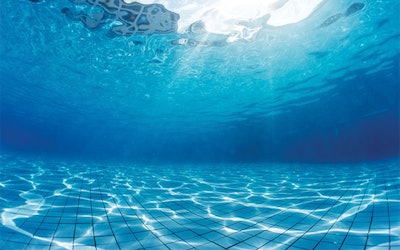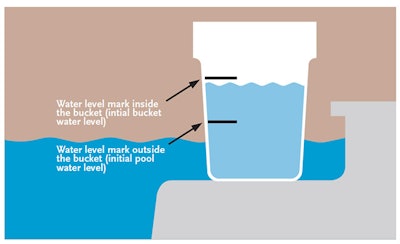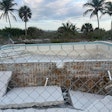
I got a call from a pool service tech. He said, "My salt level has gone down from 3,400 ppm to 1,900 ppm, calcium hardness from 350 ppm to 230 ppm and my CYA is down 30 ppm. Do you have any idea why this is happening?"
"How long did it take for the readings to go down?"
"Well, I checked it a couple of months ago, but they usually don't change so I don't test them very often."
This situation — a leaking pool — is not that unusual. There may be a single large leak or many small leaks that are cumulatively discharging a considerable amount of water. Recognizing that a pool is losing water is difficult with automatic refill devices and regions with high evaporation. The lost water is replaced automatically, and no one knows how much water is being replaced. (It would be cool to put a water meter on a pool refill line sometime.) Most people think in terms of the lost water, but it is not just the cost of water that is important.
Water loss means that the water chemistry is being diluted and more chlorine may be needed, more CYA to protect the chlorine, salt may be lost, and salt generators may have to run longer to make chlorine. So, more electricity is needed, salt cells may develop scale quicker, and more frequent cleaning may be needed. The pH may be increasing because the salt generator is running longer. The pump may need to run longer because the salt generator needs to run longer. Water balance may be off requiring more time and chemicals to balance. If not attended to, corrosive water and staining may result. The pH buffering capacity is changed due to lower total alkalinity, lower CYA, and lower borate levels (if used).
COMPLETE WATER TESTING NOT USUALLY PERFORMED
The reason these chemical changes — indicating a possible leak — can go unnoticed is that most service techs do not test for all seven or eight water conditions every time they visit a pool. Testing for everything is expensive, time-consuming, and four to five of the tests never change much under normal circumstances. The only water conditions that change frequently are free chlorine, pH and total alkalinity.
RELATED: Backyard Disaster: The Sand Trap Pool
So, weekly tests of calcium hardness, CYA, borate, salt and TDS are often deemed unnecessary. Many service techs only test for these water conditions once a month or even every couple of months, which can mask the loss, but a pool that is losing water is costing you money, time and effort.
If borate is low, fewer algae are prevented, more chlorine is needed, and the pH can rise quicker. If CYA is lower, the UV protection is lowered requiring more chlorine. And the pH buffering against pH decrease is lowered. Lowering the calcium level can create corrosive water conditions, a negative LSI or even plaster and grout problems. Low salt can cause premature salt cell damage, cause less chlorine to be made and require longer run times. None of these changes are noticeable week to week as they occur in small increments.
 If the level of the pool water is dropping faster than the level of the water in the bucket, there's a leak.
If the level of the pool water is dropping faster than the level of the water in the bucket, there's a leak.
WATER LOSS GOES UNNOTICED BUT CAN BE HUGE
Let's look at an example. A typical leak can result in a drop of water level of 2 inches per week. If the average depth of the pool is 4 feet 6 inches or 54 inches (shallow end of 3 feet and a deep end of 6 feet equals an average depth of 4.5 feet), then over the course of a couple months (9 weeks), the water loss is 18/54 or 33.3% water volume loss!
If the pool is automatically refilled, you are unaware this is happening. But you may be wondering why this pool uses more chlorine than others, why the pH and alkalinity are always changing, why the salt level has gone down by 800 ppm, why borate is half of the 50 ppm you added, why CYA is half of the 50 ppm you adjusted it to, why calcium hardness has dropped by 100 ppm, and why TDS is going down.
RELATED: Pump Troubleshooting for Pool Openings, Part 1
If a pool does not have a salt generator, how much extra chlorine did this require? How much extra acid or bicarb did you need because CYA, borate, and different pH and total alkalinity water added to replace the lost water? Depending on the service contract, these extra chemical costs may come out of the pool tech's pocket.
It is normal for calcium hardness and TDS to go up due to evaporation loss. Seeing these going down should be another indicator that water is being lost. Learn the evaporation rate in your area so you can know what to expect. You can either look up the evaporation rate in your area on the internet or you can do a bucket test. This not only tells you the evaporation rate, but whether or not the pool is leaking.
BUCKET TESTING CONFIRMS LEAKS OR EVAPORATION
Fill a bucket with water and mark the level with a marker, a piece of tape, or measure from the top down and record the distance. Mark the level in the pool in the same manner. Then return in a few days or a week and see what the evaporation rate is and see if the loss is the same for the bucket and the pool. If the pool level is dropping faster, it's leaking.
RELATED: Troubleshooting Pool Leaks
More frequent water testing will show you whether a pool has leaks or not and can stanch the hidden losses of water and chemicals described above. My advice is to test the water for everything every other week during the season and keep accurate records of water tests and chemical additions. Don't rely on the salt generator "Low Salt" alarm or indicator to show you when the salt is low and therefore that the pool is losing water. Unless the onboard salt tester has been calibrated for that pool, the salt indicator may not come on when the salt level is low.
By regularly reviewing your records and the history of an account, you can tell if problems like water loss are developing and take care of them before they become a major problem. The review can also be a great way to determine that account's profitability for your business.
Since joining the industry in 1973, Robert Lowry has started two chemical companies (Robarb and Leisure Time Chemicals), authored 12 books, co-founded Service Industry News and developed 111 products. He has worked as an independent consultant since 1995. An industry icon for decades, he has educated thousands of professionals on pool and spa water chemistry.











































